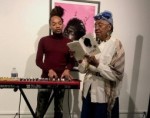
Curating as Caring-- Curating for Live Arts Contribution
by Barbora Příhodová
“Curators are the new rock stars,” we read in a 2007 Observer article, chronicling the glamour-struck working method of Klaus Biesenbach, then freshly appointed as a chief curator of the MoMA’s new media department. Biesenbach merged art with celebrity culture, cruising the globe in his “trademark snug-fitting Jil Sander suits and black-on-black shirt-and-tie combinations.” Fast forward to 2017: the critics are raving about The Square, an uber-dark satire of the art world as an absurd, marketing-driven spectacle that shows its main character, a curator in a contemporary art museum in Sweden, as a self-absorbed, pretentious prick, blissfully detached from his surrounding reality (at least until confronted by a young immigrant boy).
Indeed, curator and curating are deeply ambiguous, contested terms these days, even as they leave the traditional visual art institutions and enter the more ephemeral arena of performing arts. That is why Curating for Live Arts: Critical Perspectives, Essays, and Conversations on Theory and Practice, a new book edited by Dena Davida, Jane Gabriels, Véronique Hudon, and Marc Pronovost, is such a welcome and important contribution to the discussion on curating in general, and on curating for live arts as an emerging field in particular. “Live arts” is a term deliberately chosen by the editors as a “more inclusive description for multiple, experimental, and new practices in performance at this time” (p. 8). The editors are curators, artists, and academics active in the International Community of Performing Arts Curators founded in Québec.
This impressive volume is comprised of 38 chapters and 14 shorter curatorial statements by a group of culturally diverse voices—we do get to hear from outside of the dominant Euro-American cultural space, though most of the contributions cover Canada and the U.S. These writers present a wide array of perspectives on curating for time-based performative art forms, spanning site-specific interventions, performance art and music, as well as community devised theatre, sound art, and poetry-reading in public spaces. tD readers will appreciate that a good portion of the writing is dedicated to curating dance.
Across its six rich parts (Historical Framings, Ethical Proposals, The Artist-Curators, Exhibitions as Events, Artivism, and Institutional Reinventions), the book argues for curating as an essential component of contemporary live arts, both within institutions and outside, and a powerful agent that situates the arts right at the center of community life. Fumi Adewole with Jareh Das explain how curating has been instrumental in creating space for critical discourse about dance and performance art in Africa and for creating a “site for reflecting on African modernity” (p. 47). Kan Takikuchi reveals the state-promoted strategy to use performing arts curation as one of the tools of nation-building in Singapore. In this view, the curator is a model for the imagined “Renaissance Singaporean” as they are both “rooted in Asia and sensitive to the cultural specificity of the region on one hand and capable of exposing themselves to the universal market on the other” (p. 67). Arnaldo Rodríguez Bagué, analyzing his curatorial project of local performance artists/professors and students intervening in the spaces of the Universidad de Puerto Rico, Recinto de Río Piedras, frames curating as a “decolonial gesture” that “produce[s] an alternative cultural space for experimentation in the production of bodily and situated knowledge production” (p. 343).
What stands out in the volume is that many of the authors envision curating as based on the ethics of care – caring for the artist, caring for the community, caring for the world around. This notion of curating as caring casts it as a critical, (self)reflective practice accompanied by certain responsibilities and is grounded in the critique of neoliberal ideology that treats arts as a commodity. This is particularly emphasized in the sections Ethical Proposals and Artivism. Here, Thomas F. DeFrantz highlights the “compromised…ethics” of performing in museums (reflected by the “lack of physical infrastructure for the preparation of dancers in the non-existent ‘back-stage’ environments,” as well as by the fact that museum curators are not trained to understand the specific needs of dancers, pp. 96-97). From there, DeFrantz discusses the contemporary educational institutions for curators, such as the Institute for Curatorial Practice in Performance at Wesleyan University, pointing out that, as well-intended as they are, they are necessarily “tied to the economics of borrowing and the creation of debt that surround the education industry” (p. 97).
Focusing on the United States in particular, Naomi M. Jackson uses the example of contemporary-dance global stars Trajal Harrell and Jérôme Bel, two artists well-known to Philadelphia audiences of the FringeArts Festival, to reveal how a “handful” of institutions—Jackson names the Institute of Contemporary Art in Boston, the Walker Art Center in Minneapolis, REDCAT in Los Angeles, and the Portland Institute of Contemporary Art as her major examples—and their representatives, driven by “certain economic forces,” connect “select spaces and individuals, ideas and dollars, across time and space,” and function as taste-makers that define “what is considered ‘the best’ and ‘cutting edge’ contemporary dance” (p. 102). In her essay, Jackson robustly criticizes this elitist power dynamics and calls for “democratizing curation” (p. 110).
It is encouraging to see (and Jackson notices as well) that a number of curatorial projects and practices discussed in the book, both from the past and the present, have embraced the call. Among them is Jane Gabriels’ project Familias (in chapter “Familias: Artist-Activist Curation in the South Bronx, New York,” pp. 155-65) and the California-based curatorial collective SEPTA with their “inclusive, experimental, and eccentric” curation (p. 205; above see photo of performance by Zulfikar Ali Bhutto curated by SEPTA). It is interesting to note that Philip Bither, the Senior Curator of Performing Arts at the Walker Art Center, thus an institution Jackson identifies as one of the national tastemakers, is also represented with his short essay on “Rethinking the Role of Institutions and Curators” (pp. 315-19).
The emphasis on curating as caring-for permeates this whole thought-provoking book. I was impressed by its range and by the impulses it generates, yet, at times I found myself yearning for more editorial guidance—for more care for the reader, so to speak. Avoiding a single master narrative as opposed to offering a multitude of nonhierarchical perspectives could have been a deliberate move from the editors. But because the book doesn’t really have a critical introduction (though the excellent prologue by Florian Malzacher and epilogue by Tom Sellar substitute for that to a certain degree), the reader is left to wander around and put the pieces together on their own. If, as I did, you read the book from its beginning to its end, you will perhaps hear too many times about the etymology of “curate” (from the Latin “curare”) or that curating for the live arts proliferated in the 1990s. This is, however, a minor objection: you will almost certainly be rewarded by immersing yourself into this 392-page, effervescent cocktail of ideas, analyses, and propositions.
Anyone interested in the significance, purpose, or agenda of curating and curators in performing arts should read this book. The curators promoted here are not rock stars, they don’t wear expensive designer clothing or hang out with celebrities, but they are deeply committed to their work, to the artists they work with, and to the communities they serve.
Dena Davida, Jane Gabriels, Véronique Hudon, and Marc Pronovost, eds., Curating for Live Arts: Critical Perspectives, Essays, and Conversations on Theory and Practice. New York and Oxford: Berghahn Books, 2019. 416 pp.
By Barbora Příhodová
April 19, 2019






.png)


